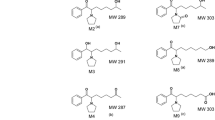Summary
Analysis by gas chromatography (GC) of the volatile compounds present in the urine from rats administered dioxane, a hepatic carcinogen to this species, revealed a major metabolite. The appearance of the metabolite was pH-dependent, undetectable at high pH; reacidification of the urine sample brought about the reappearance of the metabolite. The amount excreted was dose-dependent and time-dependent, reaching a maximum between 20 and 28 h after dioxane administration. Diethylene glycol administered to rats gave rise to the same metabolite. When isolated and purified from lyophilized urine by preparative GC, the metabolite exhibited an intense carbonyl band at 1750 cm−1 in the infrared spectrum. Nuclear magnetic resonance spectrum showed two triplets and one singlet with equal intensity at δ 3.85, 4.48 and 4.37, respectively. GC-mass spectrometric studies indicated a parent peak at m/e 102. The metabolite was identified as p-dioxane-2-one. Synthetic reference compound exhibited identical IR, NMR, and GC-mass spectra as the metabolite. The tentative pathway and the biological significance of dioxane metabolism are discussed.
Similar content being viewed by others
References
Argus, M. F., Arcos, J. C., Hoch-Ligeti, C.: Studies on the carcinogenic activity of protein denaturing agents: Hepatocarcinogenicity of dioxane. J. Natl. Cancer Inst. 35, 949–958 (1965)
Argus, M. F., Sohal, R. S., Bryant, G. M., Hoch-Ligeti, C., Arcos, J. C.: Dose-response and ultrastructural alterations in dioxane carcinogenesis. Influence of methylcholanthrene on acute toxicity. Eur. J. Cancer 9, 237–243 (1973)
Barber, H.: Haemorrhagic nephritis and necrosis of liver from dioxan poisoning. Guy's Hosp. Rep. 84, 267–280 (1934)
Braun, W. H., Young, J. D.: Identification of β-hydroxyethoxyacetic acid as the major urinary metabolite of 1,4-dioxane in the rat. Toxicol. Appl. Pharmacol. 39, 33–38 (1977)
Carothers, W. H., Dorough, G. L., Van Natta, F. J.: Studies of polymerization and ring formation. X. The reversible polymerization of six-membered cyclic esters. J. Am. Chem. Soc. 54, 761–772 (1932)
Dickens, F.: Carcinogenic lactones and related substances. Brit. Med. Bull. 20, 96–101 (1964)
Fairley, A., Linton, E. C., Ford-Moore, A. H.: Note on the toxicity to animals of some oxidation products of 1:4-dioxan. J. Hygiene 35, 341–347 (1936)
Hausman, E. R., McAnally, J. S., Lewis, G. T.: Determination of oxalate in urine. Clin. Chem. 2, 439–444 (1956)
Hoch-Ligeti, C., Argus, M. F., Arcos, J. C.: Induction of carcinomas in the nasal cavity of rats by dioxane. Br. J. Cancer 24, 164–167 (1970)
Hollo, E.: Untersuchungen über den Einfluß des Ring-Sauerstoff-atoms auf die Reaktionsgeschwindigkeit gewisser Lactone. Ber. 61, 895–906 (1928)
Johnstone, R. T.: Death due to dioxane? Arch. Industr. Health 20, 445–447 (1959)
Kociba, R. J., McCollister, S. B., Park, C., Torkelson, T. R., Gehring, P.: 1,4-Dioxane. I. Results of a 2-year ingestion study in rats. Toxicol. Appl. Pharmacol. 30, 275–286 (1974)
Kruger, F. W., Bertram, B., Eisenbrand, G.: Metabolism of nitrosamines in vivo. V. Investigation on 14CO2 exhalation, liver RNA labelling and isolation of two metabolites from urine after administration of [2,5-14C]-dinitrosopiperazine to rats. Z. Krebsforsch. 85, 125–134 (1976)
Lorentzen, R. J., Caspary, W. J., Lesko, S. A., Ts'o, P. O. P.: The autooxidation of 6-hydroxybenzo[a]pyrene and 6-oxobenzo[a]-pyrene radical, reactive metabolites of benzo[a]pyrene. Biochemistry 14, 3970–3977 (1975)
Richter, G. H.: Textbook, of Organic Chemistry, p. 327. New York: John Wiley & Sons 1938
Wiley, F. H., Hueper, W. C., Bergen, D. S., Blood, F. R.: The formation of oxalic acid from ethylene glycol and related solvents. J. Industr. Hyg. Toxicol. 20, 269–277 (1938)
Woo, Y.-T. Arcos, J. C., Argus, M. F., Griffin, G. W., Nishiyama, K.: In vivo metabolism of dioxane: Identification of p-dioxane-2-one as the major urinary metabolite. 173rd Meeting Am. Chem. Soc., New Orleans, March, Abstract No. 79 MEDI (1977a)
Woo, Y.-T., Argus, M. F., Arcos, J. C.: Effect of inducers and inhibitors of mixed-function oxidases on the in vivo metabolism of dioxane in rats. Proc. Am. Assoc. Cancer Res. 18, 165 (1977b)
Author information
Authors and Affiliations
Rights and permissions
About this article
Cite this article
Woo, YT., Arcos, J.C., Argus, M.F. et al. Structural identification of p-dioxane-2-one as the major urinary metabolite of p-dioxane. Naunyn-Schmiedeberg's Arch. Pharmacol. 299, 283–287 (1977). https://doi.org/10.1007/BF00500322
Received:
Accepted:
Issue Date:
DOI: https://doi.org/10.1007/BF00500322




